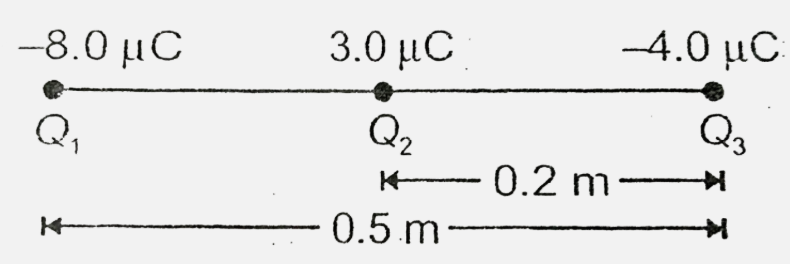A force →F1 when added to a force −→F2=3i−5j gives a resulant force ¯¯¯F=−4i. Then ¯¯¯F1 is given by
7i+5j
−7i+5j
7i−5j
none
The correct Answer is:B
Topper's Solved these Questions
- VECTORSBOOK - AAKASH SERIESCHAPTER - VECTORSEXERCISE - Additional Practice Exercise (Level-II Lecture Sheet (Advanced)) (Straight Objective Type Questions)
4 Videos
- VECTORSBOOK - AAKASH SERIESCHAPTER - VECTORSEXERCISE - Additional Practice Exercise (Level-II Lecture Sheet (Advanced)) (More than one correct answer Type Questions)
1 Videos
- VECTORSBOOK - AAKASH SERIESCHAPTER - VECTORSEXERCISE - Practice Sheet (Exercise-III) (Multiplication of Vectors (Level-II)) (Linked Comprehension Type Questions)
2 Videos
- UNITS AND MEASUREMENTS BOOK - AAKASH SERIESCHAPTER - UNITS AND MEASUREMENTS EXERCISE - ADDITIONAL PRACTICE EXERCISE (PRACTICE SHEET (ADVANCED))
14 Videos
- VISCOSITY BOOK - AAKASH SERIESCHAPTER - VISCOSITY EXERCISE - Questions for Descriptive Answers
3 Videos
Similar Questions
Two forces →F1=500N due east and →F2=250N due north have their common initial point. →F2−→F1 is
View SolutionA body placed in free space, is simultaneously acted upon by three forces −→F1,−→F2 and −→F3. The body is in equilibrium and the forces −→F1 and −→F2 are known ot be 36 N due north and 27 N due east respectively. Which of the following best describes the force −→F3?
View Solution
Knowledge Check
A body is moving under the action of two force −→F1=2ˆi−5ˆj , −→F2=3ˆi−4ˆj . It's velocity will become uniform under a third force −→F3 given by.
A5ˆi−ˆjB−5ˆi−ˆjC5ˆi+ˆjD−5ˆi+9ˆjA body is moving under the action of two force −−−−−−−−−−→F1=2ˆi−5ˆj , −−−−−−−−−−→F2=3ˆi−4ˆj . Its velocity will become uniform under a third force −→F3 given by.
A5ˆi−9ˆjB−5ˆi−9ˆjC5ˆi+9ˆjD−5ˆi+9ˆjA body is moving under the action of two force −−−−−−−−−−→F1=2ˆi−5ˆj , −−−−−−−−−−→F2=3ˆi−4ˆj . Its velocity will become uniform under a third force −→F3 given by.
A5ˆi−ˆjB−5ˆi−ˆjC5ˆi+ˆjD−5ˆi+9ˆj
Two forces →F1=3ˆi+4ˆj and →F2=3ˆj+4ˆk are acting simultaneously at a point. What is the magnitude of the resultant force ?
View SolutionThree charged particles are arranged in a line,as shown in figure.Calculate the net electrostatic force on particle3 ( the -4.0μC on the right ) due to the other two charges.

Strategy : The net force exerted on 3by particle 1 is the resultant of the force ¯¯¯¯¯F31 exerted on 3 by particle 1 and the force ¯¯¯¯¯F32 exerted on 3 by particle 2, ¯¯¯F=¯¯¯F31+¯¯¯F32
View SolutionTwo forces −→F1and−→F2 are acting at right angles to each other , find their resultant ?
View SolutionTwo forces →F1=500N due east and →F2=250N due north have their common initial point. →F2−→F1 is
View SolutionA body placed in free space, is simultaneously acted upon by three forces −→F1,−→F2 and −→F3. The body is in equilibrium and the forces −→F1 and −→F2 are known ot be 36 N due north and 27 N due east respectively. Which of the following best describes the force −→F3?
View Solution
